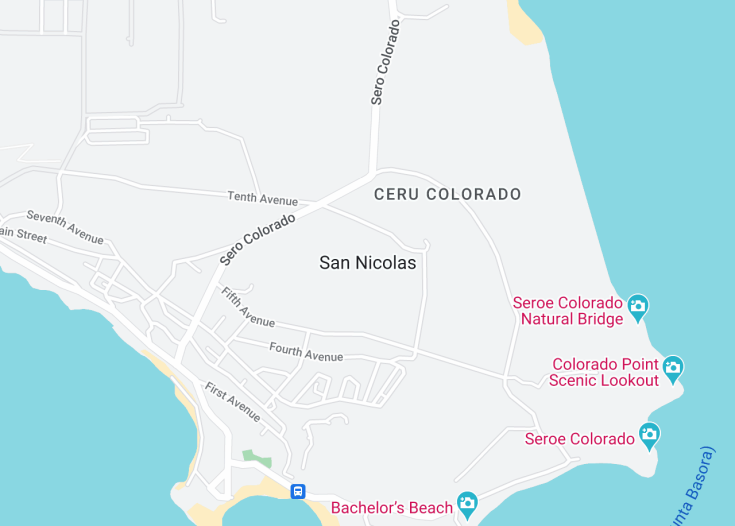Sint Nicolaas, Aruba’s southernmost city, is a fascinating blend of cultural history and industrial vibrance. Once a bustling oil refinery town, it has transformed into a burgeoning center for arts and culture. Its charming streets are lined with colorful murals and Caribbean architecture, offering a distinct contrast to the more tourist-heavy areas of the island. Key attractions include Baby Beach, known for its shallow waters and snorkeling, and the Sint Nicolaas Art Foundation, which promotes local artistic endeavors.
For a unique experience, visit during the Sint Nicolaas Art Festival when the city comes alive with live performances and outdoor art displays.
Consider exploring the nearby Rodgers Beach for a quieter, less crowded alternative to the popular Baby Beach, perfect for a day of serene relaxation.
Top things to do & see in Sint Nicolaas
Select the following sights and activities to discover best tickets and tours available in Sint Nicolaas.
Sint Nicolaas: A Gateway to Aruba’s Industrial History
| Country | Aruba (Netherlands) |
| Time in Sint Nicolaas | GMT-4 |
| Language spoken | Dutch |
| Population | 19,446 (2022 Census) |
| Currency | Aruban florin (AWG) |
| Airports | Queen Beatrix International Airport (5 mi / 8 km). |
Sint Nicolaas, the second capitol of Aruba, has a rich tapestry of history and culture. Located on the southern coast, this town’s development is heavily tied to the oil refining industry which was once the backbone of Aruba’s economy. Established in 1924 alongside the initiation of the oil refinery, Sint Nicolaas played a critical role in the economic boom that lasted till the late 20th century.
The town’s architectural styles are influenced heavily by the influx of foreign workers in the mid-20th century, showcasing a blend of Caribbean and colonial Dutch designs. The cultural diversity here is vibrant, testament to the various nationalities that have inhabited the area over decades. Historical landmarks such as the Nicolaas Church and the Cultural Center offer glimpses into the rich history and developmental journey of Sint Nicolaas.
Where is Sint Nicolaas?
Located on the southern coast of Aruba, near the island’s eastern tip, Sint Nicolaas serves as an enticing destination for history enthusiasts.
Distances:
| Route | Distance by car | Time by car |
|---|---|---|
| From Oranjestad to Sint Nicolaas | 12 miles | 20 minutes |
| From Noord to Sint Nicolaas | 15 miles | 25 minutes |
What is Sint Nicolaas famous for?
Sint Nicolaas is renowned for its historical significance in Aruba’s oil industry and its multicultural influences, making it a fascinating snapshot of industrial heritage.
History
Pre-colonial Period (Before 1499)
Sint Nicolaas’s earliest inhabitants were the Arawak Indigenous peoples, specifically the Caquetío tribe, who arrived from the South American mainland. They settled primarily along the coastal areas, engaging in fishing, farming, and salt collection, leading a relatively peaceful existence.
Spanish Colonization (1499-1636)
Spanish explorers led by Alonso de Ojeda arrived in 1499, marking the beginning of European influence. The island was claimed for Spain but was not significantly developed due to its perceived lack of gold resources. The Caquetío people were subjected to enslavement and forced relocation, which drastically reduced their population and cultural presence on the island.
Dutch Control and Development (1636-Present)
Control of Aruba shifted to the Dutch in 1636, who developed the island for its strategic location and natural resources. Sint Nicolaas became vital due to the discovery of phosphate deposits in the 19th century and later, the establishment of an oil refinery in the 1920s by Lago Oil and Transport Co. This period led to an economic boom, transforming Sint Nicolaas into a bustling center of commerce and industry. The town saw significant immigration, including a diverse array of workers who contributed to its demographic and cultural composition.
Modern Era (20th Century to Present)
In recent decades, after the decline of oil processing industries, Sint Nicolaas has been focusing on revitalizing its economy and cultural heritage. Efforts to boost tourism have been particularly noteworthy, with the town embracing its rich history, multicultural background, and unique attractions to draw visitors from around the globe.
Visit Sint Nicolaas
What to see and do in Sint Nicolaas, Aruba (Netherlands)
Explore the rich history and vibrant culture of Sint Nicolaas. Visit the San Nicolas Church, an architectural gem that reflects the town’s colonial past. Wander through the streets adorned with colorful murals, showcasing the artistic talent of local and international artists. For beach enthusiasts, Baby Beach offers pristine sandy shores and excellent snorkeling opportunities.
- San Nicolas Church
- Street art murals
- Baby Beach
- Cultural Museum of Industry
- Local market tours
Cultural Festivals in Sint Nicolaas
Sint Nicolaas is known for its vibrant cultural scene, particularly during the annual Carnival. Celebrated in the early months of the year, this event is a display of elaborate costumes, parades, and music that lights up the town with energy and festivity. Another significant event is the San Nicolas Day Festival in December, honoring the town’s patron saint with music, dance, and local food.
Best time to visit Sint Nicolaas
The best time to visit Sint Nicolaas is from January to March, during the dry season when the weather is most favorable for outdoor activities and events, including the grand Carnival celebrations.
Is Sint Nicolaas worth visiting?
Sint Nicolaas is indeed worth visiting for those who appreciate a blend of history, culture, and natural beauty. The town offers a unique insight into Aruba’s past with its historical sites and cultural displays, while also providing beautiful beaches and a warm, welcoming atmosphere year-round. Whether you’re a history buff, art aficionado, or beach lover, Sint Nicolaas presents an array of attractions that cater to various interests.










